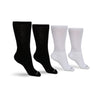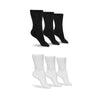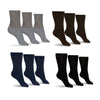Translation missing: en.collections.general.collection_label: The Best Men's Diabetic Socks
Criteria for our Best Men’s Diabetic Socks of 2025
To make our Best Men’s Diabetic Sock List, these products have met our three criteria:
- They have been out in the marketplace for at least three years.
- Manufactured to the highest quality standards.
- Foot care professionals involved with treating diabetic foot care on a daily basis have recommended these socks.
Here’s our list of the top 5 Diabetic Socks for men in 2025:
- Men’s Ultra-soft Socks
- Men’s Cotton Crew Socks
- Men’s Assorted Cotton Crew Socks
- Men’s Cotton Ankle Socks
- Men’s Compression Stockings
Why Should Men With Diabetes Use Diabetic Socks?
According to most studies, more than half of the people who have diabetes experience nerve damage. People with diabetes indeed have notoriously sensitive feet caused by nerve damage, or what is also known as diabetic neuropathy. This neuropathy can lead to increased sensitivity, tingling sensations, numbness, pain, and discomfort.
Men who have diabetes can develop diabetic neuropathy, but these 5 risk factors can make them more likely to get nerve damage:
- Poor blood sugar control - uncontrolled blood sugar means your blood sugar is too high and puts you at risk of every diabetes complication that can damage your nerves.
- Being overweight - a body weight greater than what is considered healthy (Having a body mass of 25 and above) can increase your risk of diabetic neuropathy.
- Smoking - Smoking shrinks and hardens your arteries, causing you to reduce the blood flow in your legs and feet, resulting in difficulty in healing wounds in your body and damaging your peripheral nerves.
- Kidney Disease- the high level of sugar in the blood damages tiny filtering units of each kidney and eventually leads to kidney failure. Around 20 - 30 percent of people develop kidney disease, which can lead to nerve damage.
- A history of diabetes in the family - type 2 diabetes can be hereditary. This doesn't guarantee you will develop it if your mother or father has or has diabetes, but this means that you have a greater chance of having type 2 diabetes.
Where To Get The Best Diabetic Socks for Men
DSC offers high-quality, soft, non-binding diabetic socks in different shapes and forms that can cater to all of your needs, as you better manage diabetes. You may even fill out a quiz to see which type of diabetic socks for men would suit you the best.
Diabetic Foot Health is very crucial, no matter how minor it may seem to the naked eye. It is essential that men stay on top of their feet' condition and take the necessary steps to prevent more significant issues, such as pain, discomfort, and infections. Wearing the proper footwear like diabetic socks is vital to the improvement of your quality of life.
-
Men's Ultra-Soft Upper Calf Diabetic Socks (4 Pair) - Large (shoe size 9-12) / White
- Translation missing: en.products.product.regular_price
- $79.95
- Translation missing: en.products.product.sale_price
- $39.99



-
Men's Ultra-Soft Upper Calf Diabetic Socks (4 Pair) - Large (shoe size 9-12) / Black
- Translation missing: en.products.product.regular_price
- $79.95
- Translation missing: en.products.product.sale_price
- $39.99



-
Men's Ultra-Soft Upper Calf Diabetic Socks (4 Pair) - Large (shoe size 9-12) / Assorted
- Translation missing: en.products.product.regular_price
- $79.95
- Translation missing: en.products.product.sale_price
- $44.99



-
Men's Cotton Diabetic Crew Socks (6 Pair) - Large (shoe size 9-12) / White
- Translation missing: en.products.product.regular_price
- $79.95
- Translation missing: en.products.product.sale_price
- $39.99






-
Men's Cotton Diabetic Crew Socks (6 Pair) - Large (shoe size 9-12) / Black
- Translation missing: en.products.product.regular_price
- $79.95
- Translation missing: en.products.product.sale_price
- $39.99






-
Men's Cotton Diabetic Crew Socks (6 Pair) - Large (shoe size 9-12) / Grey
- Translation missing: en.products.product.regular_price
- $79.95
- Translation missing: en.products.product.sale_price
- $39.99






-
Men's Cotton Diabetic Crew Socks (6 Pair) - Large (shoe size 9-12) / Beige
- Translation missing: en.products.product.regular_price
- $79.95
- Translation missing: en.products.product.sale_price
- $39.99






-
Men's Cotton Diabetic Crew Socks (6 Pair) - Large (shoe size 9-12) / Brown
- Translation missing: en.products.product.regular_price
- $79.95
- Translation missing: en.products.product.sale_price
- $39.99






-
Men's Cotton Diabetic Crew Socks (6 Pair) - Large (shoe size 9-12) / Navy
- Translation missing: en.products.product.regular_price
- $79.95
- Translation missing: en.products.product.sale_price
- $39.99






-
Men's Cotton Diabetic Crew Socks (Assorted) - Large (shoe size 9-12) / 6 Pair
- Translation missing: en.products.product.regular_price
- $79.99
- Translation missing: en.products.product.sale_price
- $46.95





-
Men's Cotton Diabetic Crew Socks (Assorted) - Large (shoe size 9-12) / 9 Pair
- Translation missing: en.products.product.regular_price
- $99.95
- Translation missing: en.products.product.sale_price
- $59.95





-
Men's Cotton Diabetic Crew Socks (Assorted) - Large (shoe size 9-12) / 12 Pair
- Translation missing: en.products.product.regular_price
- $115.95
- Translation missing: en.products.product.sale_price
- $74.95





-
Men's Cotton Diabetic Crew Socks (Assorted) - Large (shoe size 9-12) / 15 Pair
- Translation missing: en.products.product.regular_price
- $135.95
- Translation missing: en.products.product.sale_price
- $89.95





-
Men's Cotton Diabetic Crew Socks (Assorted) - Large (shoe size 9-12) / 18 Pair
- Translation missing: en.products.product.regular_price
- $155.95
- Translation missing: en.products.product.sale_price
- $99.95





-
Men's Cotton Diabetic Ankle Socks (6 Pair) - Medium (shoe size 6-8) / White
- Translation missing: en.products.product.regular_price
- $69.95
- Translation missing: en.products.product.sale_price
- $39.99



-
Men's Cotton Diabetic Ankle Socks (6 Pair) - Medium (shoe size 6-8) / Black
- Translation missing: en.products.product.regular_price
- $69.95
- Translation missing: en.products.product.sale_price
- $39.99



-
Men's Cotton Diabetic Ankle Socks (6 Pair) - Medium (shoe size 6-8) / Grey
- Translation missing: en.products.product.regular_price
- $69.95
- Translation missing: en.products.product.sale_price
- $39.99



-
Men's Cotton Diabetic Ankle Socks (Assorted) - Large (shoe size 9-12) / 9 Pair
- Translation missing: en.products.product.regular_price
- $89.95
- Translation missing: en.products.product.sale_price
- $49.95

-
Men's Over The Calf Compression Stocking Socks (1 Pair) - Large (shoe size 10-12) / White / 20-30mmhg (high)
- Translation missing: en.products.product.regular_price
- $41.95
- Translation missing: en.products.product.sale_price
- $29.99






-
Men's Over The Calf Compression Stocking Socks (1 Pair) - Large (shoe size 10-12) / Black / 15-20mmHg (medium)
- Translation missing: en.products.product.regular_price
- $41.95
- Translation missing: en.products.product.sale_price
- $24.99






-
Men's Over The Calf Compression Stocking Socks (1 Pair) - Large (shoe size 10-12) / Navy / 15-20mmHg (medium)
- Translation missing: en.products.product.regular_price
- $41.95
- Translation missing: en.products.product.sale_price
- $24.99






-
Men's Over The Calf Compression Stocking Socks (1 Pair) - Large (shoe size 10-12) / Brown / 20-30mmhg (high)
- Translation missing: en.products.product.regular_price
- $41.95
- Translation missing: en.products.product.sale_price
- $29.99






-
Men's Over The Calf Compression Stocking Socks (1 Pair) - Large (shoe size 10-12) / Grey / 8-15mmHg (low)
- Translation missing: en.products.product.regular_price
- $31.95
- Translation missing: en.products.product.sale_price
- $19.99






-
Men's Over The Calf Compression Stocking Socks (1 Pair) - Medium (shoe size 8-10) / Tan / 20-30mmhg (high)
- Translation missing: en.products.product.regular_price
- $41.95
- Translation missing: en.products.product.sale_price
- $29.99






























